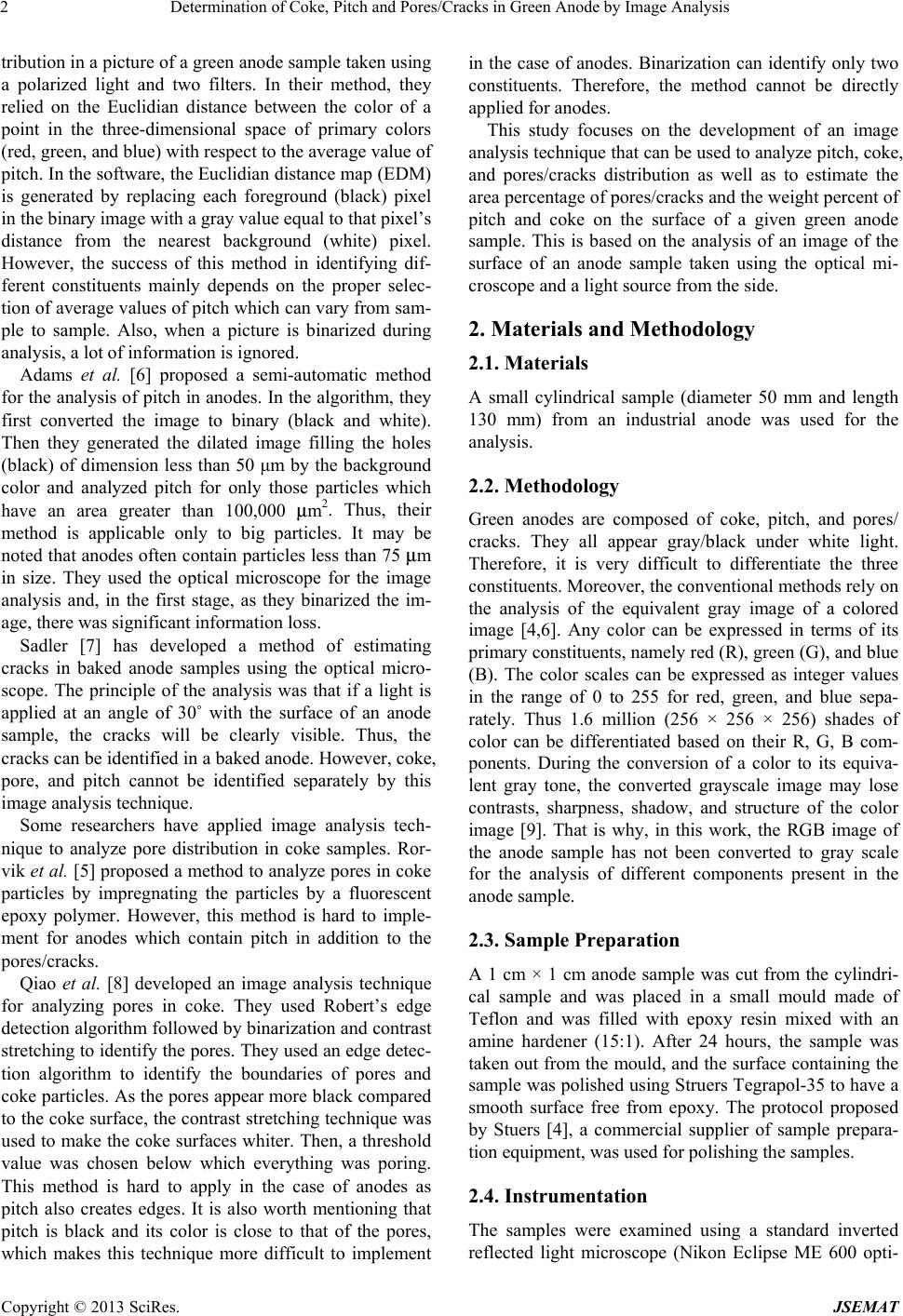
Determination of Coke, Pitch and Pores/Cracks in Green Anode by Image Analysis
2
tribution in a picture of a green anode sample taken using
a polarized light and two filters. In their method, they
relied on the Euclidian distance between the color of a
point in the three-dimensional space of primary colors
(red, green, and blue) with respect to the average value of
pitch. In the software, the Euclidian distance map (EDM)
is generated by replacing each foreground (black) pixel
in the binary image with a gray value equal to that pixel’s
distance from the nearest background (white) pixel.
However, the success of this method in identifying dif-
ferent constituents mainly depends on the proper selec-
tion of average values of pitch which can vary from sam-
ple to sample. Also, when a picture is binarized during
analysis, a lot of information is ignored.
Adams et al. [6] proposed a semi-automatic method
for the analysis of pitch in anodes. In the algorithm, they
first converted the image to binary (black and white).
Then they generated the dilated image filling the holes
(black) of dimension less than 50 μm by the background
color and analyzed pitch for only those particles which
have an area greater than 100,000 μm2. Thus, their
method is applicable only to big particles. It may be
noted that anodes often contain particles less than 75 μm
in size. They used the optical microscope for the image
analysis and, in the first stage, as they binarized the im-
age, there was significant information loss.
Sadler [7] has developed a method of estimating
cracks in baked anode samples using the optical micro-
scope. The principle of the analysis was that if a light is
applied at an angle of 30˚ with the surface of an anode
sample, the cracks will be clearly visible. Thus, the
cracks can be identified in a baked anode. However, coke,
pore, and pitch cannot be identified separately by this
image analysis technique.
Some researchers have applied image analysis tech-
nique to analyze pore distribution in coke samples. Ror-
vik et al. [5] proposed a method to analyze pores in coke
particles by impregnating the particles by a fluorescent
epoxy polymer. However, this method is hard to imple-
ment for anodes which contain pitch in addition to the
pores/cracks.
Qiao et al. [8] developed an image analysis technique
for analyzing pores in coke. They used Robert’s edge
detection algorithm followed by binarization and contrast
stretching to identify the pores. They used an edge detec-
tion algorithm to identify the boundaries of pores and
coke particles. As the pores appear more black compared
to the coke surface, the contrast stretching technique was
used to make the coke surfaces whiter. Then, a threshold
value was chosen below which everything was poring.
This method is hard to apply in the case of anodes as
pitch also creates edges. It is also worth mentioning that
pitch is black and its color is close to that of the pores,
which makes this technique more difficult to implement
in the case of anodes. Binarization can identify only two
constituents. Therefore, the method cannot be directly
applied for anodes.
This study focuses on the development of an image
analysis technique that can be used to analyze pitch, coke,
and pores/cracks distribution as well as to estimate the
area percentage of pores/cracks and the weight percent of
pitch and coke on the surface of a given green anode
sample. This is based on the analysis of an image of the
surface of an anode sample taken using the optical mi-
croscope and a light source from the side.
2. Materials and Methodology
2.1. Materials
A small cylindrical sample (diameter 50 mm and length
130 mm) from an industrial anode was used for the
analysis.
2.2. Methodology
Green anodes are composed of coke, pitch, and pores/
cracks. They all appear gray/black under white light.
Therefore, it is very difficult to differentiate the three
constituents. Moreover, the conventional methods rely on
the analysis of the equivalent gray image of a colored
image [4,6]. Any color can be expressed in terms of its
primary constituents, namely red (R), green (G), and blue
(B). The color scales can be expressed as integer values
in the range of 0 to 255 for red, green, and blue sepa-
rately. Thus 1.6 million (256 × 256 × 256) shades of
color can be differentiated based on their R, G, B com-
ponents. During the conversion of a color to its equiva-
lent gray tone, the converted grayscale image may lose
contrasts, sharpness, shadow, and structure of the color
image [9]. That is why, in this work, the RGB image of
the anode sample has not been converted to gray scale
for the analysis of different components present in the
anode sample.
2.3. Sample Preparation
A 1 cm × 1 cm anode sample was cut from the cylindri-
cal sample and was placed in a small mould made of
Teflon and was filled with epoxy resin mixed with an
amine hardener (15:1). After 24 hours, the sample was
taken out from the mould, and the surface containing the
sample was polished using Struers Tegrapol-35 to have a
smooth surface free from epoxy. The protocol proposed
by Stuers [4], a commercial supplier of sample prepara-
tion equipment, was used for polishing the samples.
2.4. Instrumentation
The samples were examined using a standard inverted
reflected light microscope (Nikon Eclipse ME 600 opti-
Copyright © 2013 SciRes. JSEMAT